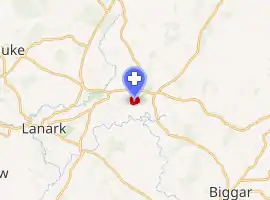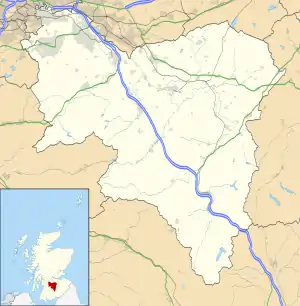State Hospital
The State Hospital (also known as Carstairs Hospital, or simply Carstairs)[1] is a psychiatric hospital near the village of Carstairs Junction, in South Lanarkshire, Scotland. It provides care and treatment in conditions of high security for around 140 patients from Scotland and Northern Ireland. The hospital is managed by the State Hospitals Board for Scotland which is a public body accountable to the First Minister of Scotland through the Scottish Government Health and Social Care Directorates. It is a Special Health Board, part of the NHS Scotland and the only hospital of its kind within Scotland.
| The State Hospital | |
|---|---|
| State Hospitals Board for Scotland | |
 Entrance to the State Hospital | |

| |
 Shown in South Lanarkshire | |
| Geography | |
| Location | Carstairs, South Lanarkshire, Scotland |
| Coordinates | 55.695395°N 3.654545°W |
| Organisation | |
| Care system | NHS Scotland |
| Type | Psychiatric |
| Services | |
| Emergency department | No |
| Beds | 140 |
| Links | |
| Website | www |
| Lists | Hospitals in Scotland |
History
Carstairs Hospital was constructed between 1936 and 1939. Although it was planned and financed as a facility for "mental defectives", it was first used as a military hospital, during the Second World War. The War Office relinquished control of the hospital in 1948, when it became the State Institution for Mental Defectives. On 1 October 1957 there was a large transfer of 90 criminally insane prisoners from the criminal lunatic department at HM Prison Perth to Carstairs, and this new combined unit became the State Mental Hospital.[2]
In 1994 the State Hospitals (Scotland) Act 1994 enabled management of the hospital to be transferred from the Secretary of State for Scotland to NHS Scotland, coming under the control of the State Hospitals Board for Scotland.[3][4]
A redevelopment of the hospital was approved by The Scottish Government in September 2007. Construction began in April 2008 and the new hospital facilities were officially opened on 26 June 2012.[5]
Security
The hospital has an alarm system that is activated if any patient escapes to alert people in the vicinity, including those in the neighbouring town of Lanark, and local villages such as Ravenstruther. The system is tested on the third Thursday of every month at 1300hrs when the all clear siren sounds.[6]
One infamous incident of a break out happened in 1976, when two patients, Thomas McCulloch and Robert Mone, murdered a nurse, a patient and a police officer with axes in an escape attempt.[7][8]
Controversies
- In August 1999, a convicted killer walked free from Carstairs after his lawyers exploited a legal loophole. Noel Ruddle, who served seven years for shooting his next door neighbour with a semi-automatic Kalashnikov type rifle in 1991, was given an absolute discharge by a sheriff because his mental illness was deemed untreatable. He admitted that he had not been cured and had also boasted about beating the system.[1] A year after his release, Ruddle escaped a prison sentence for threatening to kill a priest.[9] An emergency Bill was brought forward by the Scottish Executive to prevent further exploitation of this loophole, becoming the Mental Health (Public Safety and Appeals) (Scotland) Act 1999, the first Act of the Scottish Parliament.[10] As emergency legislation, it was repealed and replaced by the Mental Health (Care and Treatment) (Scotland) Act 2003 on 5 October 2005.[11]
- In December 2004, Michael Ferguson was allowed an unsupervised visit to see his fiancée at East Kilbride Shopping Centre. He failed to report back to Carstairs staff two hours later as agreed. First Minister Jack McConnell ordered an urgent report into the decision.[12]
- In September 2008, it was revealed that there was a cost of £630,000 a year to provide the only female patient at Carstairs State Hospital a ward to herself. Labour health spokeswoman Margaret Curran said: "This defies common sense. This cannot be in the interests of the NHS or the patient... We need immediate explanation and action."[13]
- In 2011, a nurse was accused of giving romantic messages to a patient.[14]
- In June 2013, a patient absconded while on an escorted outing to the McArthurGlen shopping centre in Livingston, and was later arrested and taken back into custody after being spotted by members of the public in Hamilton.[15]
References
- "Released killer says: 'I'm not cured'". BBC News. 5 August 1999
- "History of the State Hospital" (PDF). About Us. The State Hospital, Carstairs. Retrieved 3 January 2013.
- "State Hospitals (Scotland) Act 1994", legislation.gov.uk, The National Archives, 1994 c. 16
- "The State Hospital". www.tsh.scot.nhs.uk. The State Hospital. Retrieved 19 May 2017.
In 1994 legislation went through Parliament to bring The State Hospital legally into the National Health Service in Scotland as a Special Health Board - The State Hospitals Board for Scotland - accountable to Scottish Ministers through the Scottish Government.
- "Carstairs State Hospital officially opens after a refit". BBC News. 26 June 2012. Retrieved 29 May 2018.
- "Public Safety – About the siren". The State Hospital. Retrieved 25 May 2017.
- Carstairs State Mental Hospital Incident – Hansard, 1 December 1976
- "Life means life, Judge tells two Carstairs murderers". The Glasgow Herald. 1 March 1977. p. 1. Retrieved 30 May 2018.
- "Ruddle escapes jail over death threat". BBC News. 11 April 2001
- Ministers accused as bill wins backing. BBC News. 2 September 1999. Retrieved 14 October 2016.
- "Mental Health (Public Safety and Appeals) (Scotland) Act 1999 (repealed)". Legislation.gov.uk. The National Archives. Retrieved 14 October 2016.
- "Escaped prisoner report ordered". BBC News. 8 December 2004
- Mackinnon, Lachlan. "Revealed – the Carstairs patient who costs you £630K a year". Daily Record. 12 September 2008
- Amy Devine. "Carstairs nurse escapes ban over romantic notes to patient". Daily Record. Retrieved 19 January 2019.
- "Police arrest absconded patient George McCann - BBC News". Bbc.co.uk. 7 June 2013. Retrieved 19 January 2019.
External links
| Wikimedia Commons has media related to State Hospital for Scotland and Northern Ireland. |